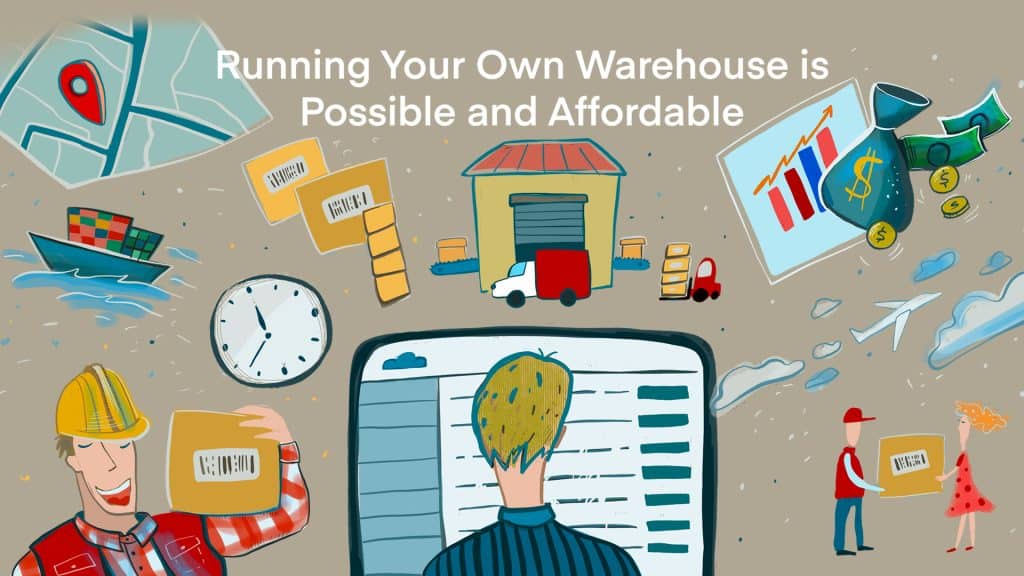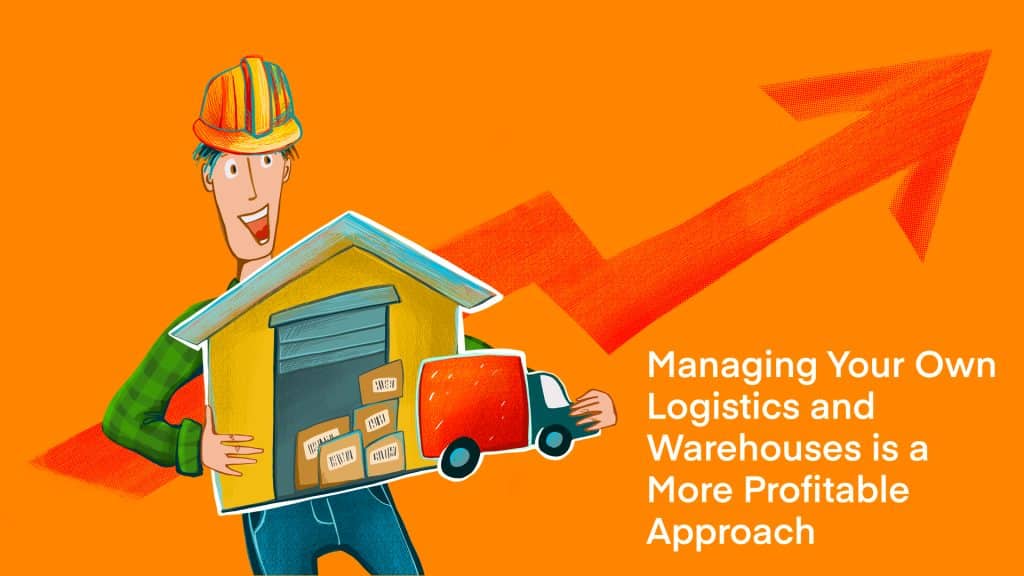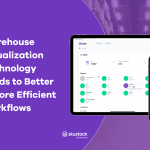
- Outsourcing warehousing and logistics can help businesses handle various tasks and fulfill orders more efficiently. However, real growth comes from managing it all in-house.
- Descartes Sellercloud is an ecommerce solution packed with features and tools to manage your business, without the need for costly fulfillment options.
It’s no secret that many ecommerce businesses start small. Whether it’s a small business run from home or a brick-and-mortar store looking to open up to an online customer base, there comes a point where the process of storing inventory and fulfilling orders outgrows the back room. As your orders increase, so do the work hours required to get out the door and the inventory you must keep on hand. It’s time to scale.
For many brands, this can lead to a search for outside help. Marketplace-based third-party logistics (3PL) services like Fulfillment by Amazon (FBA) or one of our other integrated omnichannel 3PL solutions can take some of the burden of storing and shipping orders off your hands.
Increasingly, logistics services are touting 4PL and 5PL models that take even more of the responsibilities of acquiring and maintaining fulfillment partnerships off sellers’ plates. However, while turning to a third party can be a quick fix to help you keep up, it cuts into your control over your brand and the profits you should be reaping with each sale.
The more reliant you become on outside partners for logistical success, the less benefit you will reap as your ecommerce business grows and scales. In this article, we’ll explain the difference between 1PL, 2PL, 3PL, 4PL, and 5PL, how they impact your bottom line, and why managing your logistics and warehousing is most profitable.
How the Differences Between 1PL, 2PL, 3PL, 4PL, and 5PL Impact Your Bottom Line
Ecommerce supply chains and order processing routines can look very different depending on the degree to which companies keep their logistics in-house and how much of the storage and movement of products is outsourced. Generally, the fewer partners and services involved, the greater the potential for profitability.
Ultimately, a balance must be struck between the costs and time associated with remaining independent and the potential for savings that can come with outside service partners.
1PL – First-Party Logistics
A 1PL model provides the most independence in ecommerce. In a 1PL model, the business is solely responsible for warehousing, order processing, and shipping. It requires storage space, transportation vehicles, and all the employees accompanying them. Given the far geographic reach of most modern ecommerce businesses, 1PL is pretty rare. Establishing and maintaining timely and cost-effective product distribution alone is a challenge.
What Businesses Use a 1PL Model?
Businesses that use a 1PL model want to keep everything in-house and control how everything works. They don’t want to rely on help from other companies for logistics and warehousing. Typically, businesses that follow a 1PL model are big booming businesses with a large workforce that can handle many orders that they can manage, afford, and have suitable hardware and software.
Unsurprisingly, most companies will not start out using a 1P model. Orders get very complex when going omnichannel, and companies can find that they need 3PL services to manage it all. Ideally, a business should strive to eventually become a 1PL as it gives them more control over how things are done and saves on expenses.
2PL – Second-Party Logistics
2PL models are a sweet spot for many ecommerce brands. They are a lesser-known option and can be confused with 3PLs. You may use a 2PL method, but you had no idea it even had a name. In a 2PL model, the business is largely responsible for warehousing its products but relies on shipping partners to handle distribution, both internally and when shipping to customers.
With a strong inventory management system (IMS) and warehouse management systems (WMS) like Descartes Sellercloud and its family of supporting modules, 2PL can be the ideal way for ecommerce businesses to maintain as much profitability, scalability, and independent brand control as possible (more on this later).
What Businesses Use a 2PL Model?
Businesses that use a 2PL model need help moving things from point A to point B, whether internally (for example, between warehouses) or externally to customers. A business with a good handle on its warehousing operations might consider a 2PL more appropriate for its business than a 3PL.
It is worth noting that your business could be a mix of 2PL and 1PL or 2PL and 3PL—using what is most convenient for your business. If a business can handle all its logistics and warehousing, it will follow a 1PL model instead. However, a 3PL will be a better option if they struggle with logistics and warehousing.
3PL – Third-Party Logistics
3PLs are a widely used model for outsourcing ecommerce order fulfillment. In addition to handling product and supply chain shipments, 3PL partners will take on the warehouse-level responsibilities of picking, packing, and shipping orders on a business’s behalf. Sellers must still be sure to keep their 3PL partners supplied with inventory to be able to do so.
This is one area where Descartes Sellercloud’s omnichannel inventory management features can be especially helpful. The combination of inventory tracking, low-stock alerts, and predictive purchasing can keep your business running smoothly, even if you are working with a 3PL provider.
Moreover, Descartes Sellercloud’s profit and loss (P&L) calculations can include 3PL service costs, so you can keep up with how effectively your 3PL partnerships are paying off. Simply put, 3PLs are attractive options for businesses looking to scale without crossing the threshold of full-blown warehouse management.
What Businesses Use a 3PL Model?
Many businesses rely on 3PLs, and you will hear much more about them than the other models mentioned in this article. A business that uses a 3PL model will need warehousing, logistics, and order fulfillment and will want to receive POs (purchase orders) and inventory updates from their provider, among other things.
There are many reasons why a business might want to use a 3PL business model. Some include:
- They cannot physically manage their warehouse.
- They don’t currently have a warehouse.
- They might not have the workforce to fulfill orders.
- The business grew too quickly, and orders have exceeded their ability to meet them.
- They simply want to outsource the responsibility so they can work on other things, such as marketing.
Furthermore, it is also possible that a business might just want to outsource certain parts of their business to a 3PL and keep other things in-house. For example, they may sell some private-label products and want to keep those in-house.
4PL – Fourth-Party Logistics
4PLs take things a step further beyond a simple 3PL arrangement. Rather than managing the physical movement of a business’s products, they outsource the outsourcing. 4PL services select and contract 3PL partners on your behalf.
The pitch is that they can use their expertise and business partnerships to find the ideal service to save your ecommerce business money. However, this concierge service comes at a cost that can quickly eat into those savings. Moreover, contracting a 4PL partner means handing over a significant part of your ecommerce operations to outside companies.
Should mistakes happen and customer complaints arise, third-party marketplaces and sales channels aren’t going to care that it was the company selected by your 4PL that dropped the ball; the complaints will still be tied to your brand. As such, venturing into the worlds of 4PL and beyond becomes a significantly riskier (and costlier) proposition.
What Businesses Use a 4PL Model?
A 4PL model is best suited to a business that works with multiple 3PLs and feels they spend too much time working with 3PLs and not enough on other tasks. They may use different 3PLs in different parts of the country to fulfill orders and need a 4PL to manage them, or they may want to spend more time working on different tasks, such as marketing.
5PL – Fifth-Party Logistics
The lines between 4PL and 5PL get blurry. Not everyone agrees on what defines a 5PL; they are also much less common. While a 4PL is about managing all the logistics for one company, specifically their relationships with different 3PLs, a 5PL handles multiple 4PLs and additional processes related to running your ecommerce business.
5PL providers aggregate multiple 4PL services for your company (and their other clients) and use the sheer volume of their partnerships to try to drive down shipping and storage costs. 5PLs utilize existing networks 4PLs have with 3PLs. 5PLs work with a brand, so they don’t have to deal with 4PLs or 3PLs.
5PLs typically use different software solutions, such as AI, to automate processes and make them more efficient. Again, these savings of both energy and cost are attractive, but they come with a price tag and an even further relinquishment of control over your ecommerce brand.
What Businesses Use a 5PL Model?
A business that uses a 5PL is looking to relieve itself of even more tasks. On top of outsourcing 3PL management, they also likely want to outsource their supply chain management, as 5PLs can manage their relationships with manufacturers and wholesalers. They may also want to outsource statistical analysis and decision-making, allowing 5PLs to decide the best course for certain processes.
A 5PL could be very useful when expanding to new markets. For example, you may use a 1PL method in the US but decide to use a 5PL to quickly break into the European market.

Managing Your Own Logistics and Warehouses is a More Profitable Approach
For a growing ecommerce business, a 2PL approach is likely the ideal. You have significant authority and oversight over your products and fulfillment workflows, but also benefit from partnering with established, reliable shipping infrastructure. Yet, the sticking point for many growing ecommerce businesses is warehousing.
On the surface, running a warehouse can seem overly complicated, but when your ecommerce business grows to the point where your inventory and order fulfillment needs outpace your ability to keep up, a warehousing solution becomes an unavoidable necessity. Many brands choose to sign on with a 3PL in these pivotal moments.
Unfortunately, this reliance on 3PL partners can become increasingly costly. That said, for many ecommerce sellers, moving away from a trusted third-party logistics service and taking control (and responsibility) for their own fulfillment logistics can feel risky.
The comfort and security of outsourcing distribution workflows are tough to walk away from. That’s where Descartes Sellercloud comes in. We aim to make it possible for ecommerce businesses of any type or size to take the reins of their logistics. The Descartes Sellercloud omnichannel inventory management platform makes 2PL fulfillment affordable, intuitive, and scalable.
Every aspect of managing and moving your inventory can be coordinated and tracked through a unified, cloud-based interface, keeping every team member on the same page—even across multiple offices and warehouses. We offer integrations with over a dozen domestic and international shipping providers and over 300 other top-name ecommerce partners.
With Skustack, our omnichannel ecommerce WMS platform, your warehouse can use patented inventory scanning and tracking technology to ensure that every item in your inventory can be accounted for, located, shipped, and tracked with precision. You remain in total control of your stock even as you scale across multiple locations, warehouses, and shipping partners.
Descartes Sellercloud also integrates with the scalable pick- and pack-to-light warehouse management system Skublox to help you create user-friendly and error-proof warehouse fulfillment workflows. No matter how many or how few products you move, you can be confident that every order is processed and packed quickly and correctly.
No more worrying about incomplete or incorrect orders.
Ready to take the next step in controlling the growth and profitability of your ecommerce business? Contact Descartes Sellercloud directly for a free demo.
Key Points
You’re now well aware of the differences between 1PL, 2PL, 3PL, 4PL, and 5PL and why managing your own logistics and warehousing can be the most profitable solution.
- Doing all your own warehousing and logistics is possible—your business will grow faster and save money. However, it can be hard to reach this point.
- 3PLs are the most common model, but depending on your needs, you may use various other solutions.
- 4PL and 5PL services have their benefits, but can be extremely costly when you rely on them frequently.
- Descartes Sellercloud provides the tools and features to help you manage it all efficiently without the need for costly fulfillment options.




